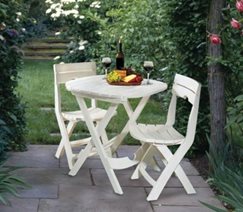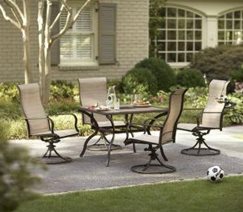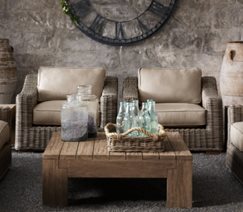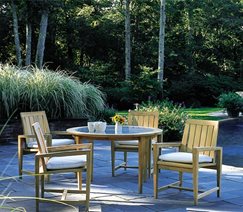How to Choose Patio Furniture
A comparison of patio furniture materials and options
By Chris Heiler, garden designer and LandscapingNetwork.com columnist
When you are picking out furniture for your living room or den, there are really only two things you need to consider: how it will match the rest of your stuff and how your rear end will feel resting in it. Which explains - in part, at least - La-Z-Boy's amazing success through the years.
But when you're shopping for outdoor furniture, there are a few more factors that you simply can't ignore. Like rain. And snow. And bugs. And pollen, and tree sap. And all the other elements that plants and other outdoor materials are designed to withstand but a lot of furniture cannot.
Here's a look at some of the common materials used to build outdoor furniture today, and how they might fit into your backyard:
Plastic Plastic patio furniture is the equivalent of IKEA everything inside. It's cheap; it works; it lasts a long time. For the most part, this is not a high-end look. If eco-friendly is your thing, look into furniture from companies like Poly-Wood, which recycles HDPE milk jugs to make the "lumber" for its line of outdoor furniture. This can be a great starter piece if you've just broken the bank on the rest of your outdoor-living ensemble and just need something to start entertaining.
Metal I know what you're thinking. "...But I've seen 'The Wizard of Oz'! The Tin Man rusts when he gets wet!" Well, we've come a long way from some shabby metal man from the 1930s. Today, manufacturers craft metal furniture out of treated wrought iron and especially coated aluminum, which stands up beautifully to the elements, provided the coating remains in tact. Visually, aluminum furniture can vary from industrial to elegant, and cost runs the gamut, too. Aluminum weighs less than wrought iron and is much less resistant to rusting.
All-weather wicker Wicker's been around for a long time, and though it's made out of synthetic resin materials these days, it was traditionally made out of tightly woven stems of various palms and formed into its finished shape. Your grandmother's wicker furniture might have been painted to match its settings (probably a covered porch), but these days, synthetic wicker can be made in most any color-and it stands up to, well, all weather.
Teak This is the miracle wood: Sourced from tropical regions, it's known for naturally containing silica, which seals and protects it from fungus and water damage. It can be very expensive (more so than cedar and others), but it's a durable, eco-friendly choice - a lot of teak is sustainably produced - that only becomes more beautiful as it ages.
A special note on cushions Unless you've got buns of steel - or a regular rear end that you don't mind feeling that way - you'll probably want good cushions to keep your outdoor furniture feeling cozy. Look into weather-proof coverings like those made by Sunbrella, a company that started out in the awning and marine industries. They're available in a wide variety of colors and patterns, to match just about any outdoor décor.
Goodness knows you wouldn't dream of putting a La-Z-Boy on the patio in your backyard, but what should you choose? The elements (and how your furniture stands up to them) should, of course, play a big part in your choice, but don't forget to consider comfort and style just as you would for your indoor furniture. This is outdoor living, you know.
Resources: Restoration Hardware
Frontgate
Kingsley Bate
Poly-Wood
Sunbrella
|
Chris Heiler is an author, speaker, and consultant for professionals in the Green Industry. |










